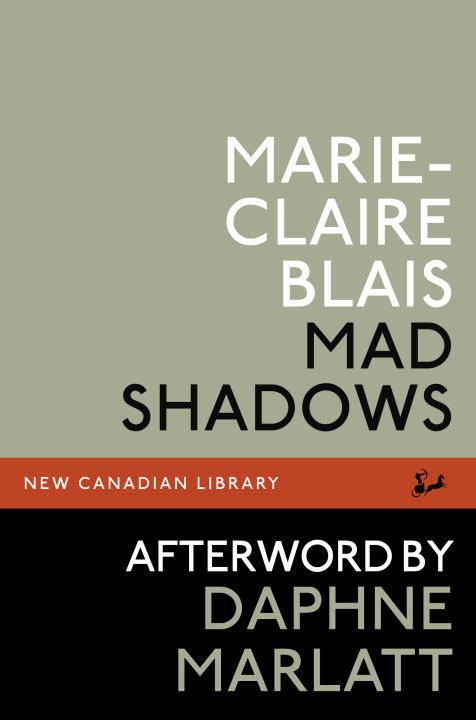7.2 /10 1 Votes7.2
Original title La Belle Bête Pages 182 Country Canada | 3.6/5 Goodreads Translator Merloyd Lawrence Publication date 1959 Originally published 1959 Page count 182 OCLC 718337426 | |||||||||||||||||||||||||||||||||
 | ||||||||||||||||||||||||||||||||||
Publisher Institut littéraire du Québec Similar A Season in the Life of Emma, Mad Shadows: The Weir, These festive nights, Manuscripts of Pauline Archange, Nights in the underground | ||||||||||||||||||||||||||||||||||
Mad Shadows (French: La Belle Bête) is a French-Canadian novel by Marie-Claire Blais, published in 1959. Writing the work at the age of twenty, the novel was Blais' first major literary work. It quickly established her as a rising talent within the Quebec literary scene.
Contents
Mad Shadows explores the psychology of a single family: Patrice, the beautiful and narcissistic son; his ugly and malicious sister, Isabelle-Marie; and Louise, their vain and uncomprehending mother. Repeatedly, the novel posits an amoral world where beauty stands hollow and love rings empty.
Main Characters
Other Characters
Plot
La Belle Bête starts off as the three main characters return home on a train. Immediately, the characters’ relationships with one another, as well as their physical beauty as a status, are established. As they return home, their daily activities reveal even more of their living situation with one another, as Isabelle-Marie is the Cinderella of the family, working hard and being neglected, while Louise fawns over her beloved beautiful Patrice. Patrice is so incompetent from his constant dependence on his mother, that he can do nothing but accept her attention. Eventually, Louise announces that she needs to travel to pick up farm equipment for their vast land, and leaves Patrice and Isabelle-Marie. Isabelle-Marie continues her distaste for her brother, and as her mother is no longer there to support Patrice, she takes the opportunity to let him starve to release her anger and jealously towards him As she grows to pity his incompetence and dependency on Louise, Isabelle-Marie begins to care for him ever so slightly.
When Louise returns, she brings with her Lanz, who becomes the new controlling figure over the family. Patrice rejoices and cleaves to his mother, but she can no longer respond with her attention as she is consumed by her own relationship with Lanz. As Lanz brings Louise further and further from her children, Patrice spirals into deterioration while Isabelle-Marie relishes her newfound freedom. As Isabelle-Marie becomes more upbeat, she learns to care for Patrice, as well as meets her lover Michael, who she convinces to love her by lying about her beauty.
From here the story splits into two. On one side of life, Isabelle-Marie begins her life with the blind Michael, while Patrice is continued to be neglected as Lanz demands the attention of Louise. Both children’s’ stories end in despair as Michael eventually regains his vision and comes to terms with the ugliness of Isabelle-Marie and consequently, their newborn child Anne. He abandons both of them and disappears from their lives. As the torn spirit of Isabelle-Marie returns to her unwanted home, she finds that Louise is being controlled by Lanz, and has chosen him over Patrice.
Her newfound anger towards outer beauty drives her to push Patrice’s face into a pot of boiling water, thus bringing his now beast-like face to her lowly status. Patrice cries to his mother, and she makes the ultimate choice to live her life with Lanz, abandoning Patrice entirely (pg 52). Patrice is sent to an insane asylum by Louise, who becomes fed up with his incompetence, however he escapes shortly afterwards. As their lives quickly become disillusioned, Isabelle-Marie ends up setting fire to the farm. Louise, who has slowly been cracking under the loss of her beautiful child, and the control – and eventual death - of her husband is lost in the fire. Isabelle-Marie commits suicide as she pushes her child off the train tracks that once brought her home, as Patrice drowns himself when he sees his hideous face in the reflection of a lake.
Adaptations
In 1977, the novel was adapted into a ballet by the National Ballet of Canada, starring dancers Karen Kain, Veronica Tennant, and choreographed by Anne Ditchburn, with music by Andre Gagnon. In 1987, commemorating the company's 35th anniversary, the show was rerun and featured Cynthia Lucas and Tomas Schramek.
In 2006, Karim Hussain adapted the work into a French film La Belle Bête. The film won the Director's Award at the Boston Underground Film Festival.
